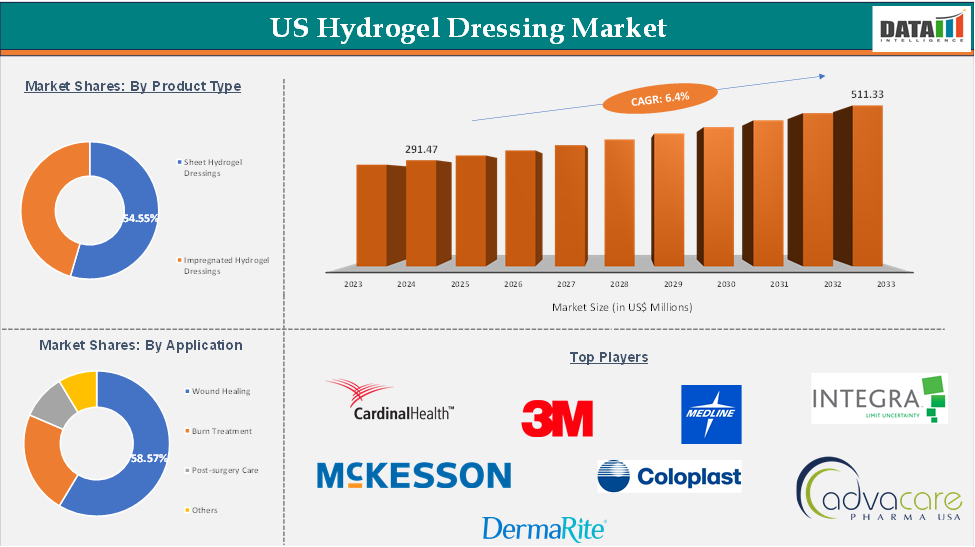US Hydrogel Dressing Market: Industry Outlook
US Hydrogel Dressing Market reached US$ 291.47 Million in 2024 and is expected to reach US$ 511.33 Million by 2033, growing at a CAGR of 6.4% during the forecast period 2025-2033.
The U.S. hydrogel dressing market is witnessing steady growth, driven by the increasing prevalence of chronic wounds, such as diabetic foot ulcers and pressure ulcers, particularly among the aging population. Hydrogel dressings, known for their high moisture content, provide an optimal healing environment by maintaining wound hydration, facilitating autolytic debridement, and offering pain relief.
These properties make them especially suitable for managing dry, necrotic, and sloughy wounds. The rising incidence of diabetes and obesity in the U.S. has further escalated the demand for advanced wound care solutions like hydrogel dressings.
Additionally, the shift towards home healthcare and the increasing adoption of minimally invasive treatments have contributed to the market's expansion. However, factors such as the high cost of hydrogel products and limited reimbursement policies may pose challenges to market growth. Despite these hurdles, ongoing technological advancements and increased awareness about the benefits of hydrogel dressings are expected to sustain the market's upward trajectory.
Executive Summary

For more details on this report – Request for Sample
US Hydrogel Dressing Market Dynamics: Drivers & Restraints
Driver: Rise in technological advancements
The U.S. hydrogel dressing market is growing due to the increasing prevalence of diabetes, which can lead to chronic complications like diabetic foot ulcers. Hydrogel dressings are beneficial for diabetic wounds as they create a moist environment, aid in faster healing, reduce pain, and minimize infection risk. The demand for effective wound care solutions is also increasing due to healthcare providers' focus on advanced wound care to improve patient outcomes and reduce wound-related complications, positioning hydrogel dressings as a preferred option for managing diabetic wounds.
For instance, according to the Centers for Disease Control and Prevention, the U.S. population has a diabetes prevalence of 11.6%, with 38.4 million people of all ages having diabetes. The percentage of adults with diabetes increases with age, reaching 29.2% among those aged 65 years or older. Undiagnosed diabetes affects 8.7 million adults aged 18 years or older, representing 3.4% of all U.S. adults and 22.8% of all U.S.
Hence, the demand for hydrogel dressings, effective wound care solutions, is increasing, especially for diabetic patients who are more susceptible to chronic wounds like diabetic foot ulcers. These dressings promote faster healing and prevent infections, making them ideal for diabetic wound management.
Restraint: High cost of treatment and inadequate reimbursement policies limit growth
The U.S. hydrogel dressing market is hindered by high costs and inadequate reimbursement policies. Despite offering advanced wound care benefits, hydrogel dressings are often more expensive than traditional dressings, making them less accessible for healthcare facilities and patients.
Reimbursement policies can be restrictive, with some insurance plans offering limited coverage or reimbursement. This financial burden discourages healthcare providers from using hydrogel dressings, especially in cost-sensitive settings, and may lead patients to choose more affordable alternatives. As a result, the widespread adoption of hydrogel dressings in the U.S. healthcare system is slow.
US Hydrogel Dressing Market Segment Analysis
The US hydrogel dressing market is segmented based on product type, application, end user, and region.
Product Type:
The amorphous hydrogel dressings segment of the product is expected to hold 54.55% of the hydrogel dressing market
The amorphous hydrogel dressings segment holds a major portion of the hydrogel dressing market share and is expected to continue to hold a significant portion of the hydrogel dressing market share during the forecast period.
Amorphous hydrogel dressings are a key player in the U.S. hydrogel dressing market due to their versatility and effectiveness in treating various wounds. These flexible, gel-like dressings are ideal for irregularly shaped or deep wounds, promoting faster tissue regeneration and reducing infection risk.
They are particularly useful for chronic wounds like diabetic foot ulcers, pressure ulcers, and surgical wounds. Their ability to absorb exudate while maintaining hydration also reduces pain and discomfort associated with dry wounds. As healthcare professionals prioritize advanced wound care solutions, amorphous hydrogel dressings are gaining popularity.
US Hydrogel Dressing Market Key Players
The major U.S players in the hydrogel dressing market include Cardinal Health, 3M Company, Medline Industries, Integra LifeSciences Corporation, McKesson Medical-Surgical Inc, DermaRite Industries, LLC, AdvaCare Pharma, Coloplast Corp, Smith & Nephew, Hollister Incorporated, and among others.
Industry Key Developments
In January 2025, Fesarius Therapeutics received FDA clearance for its DermiSphere hydrogel Dermal Regeneration Template (DermiSphere hDRT), a new class of collagen-based dermal matrices designed for tissue integration, revascularization, and wound healing, with applications in Advanced Wound Care, Reconstructive Surgery, and Regenerative Medicine.
Market Scope
Metrics | Details | |
CAGR | 6.4% | |
Market Size Available for Years | 2022-2033 | |
Estimation Forecast Period | 2025-2033 | |
Revenue Units | Value (US$ Mn) | |
Segments Covered | Product | Amorphous Hydrogel Dressings, Sheet Hydrogel Dressings, Impregnated Hydrogel Dressings |
Application | Wound Healing, Burn Treatment, Post-surgery Care, Others | |
End User | Hospitals, Specialty Clinics, Homecare, Others | |


